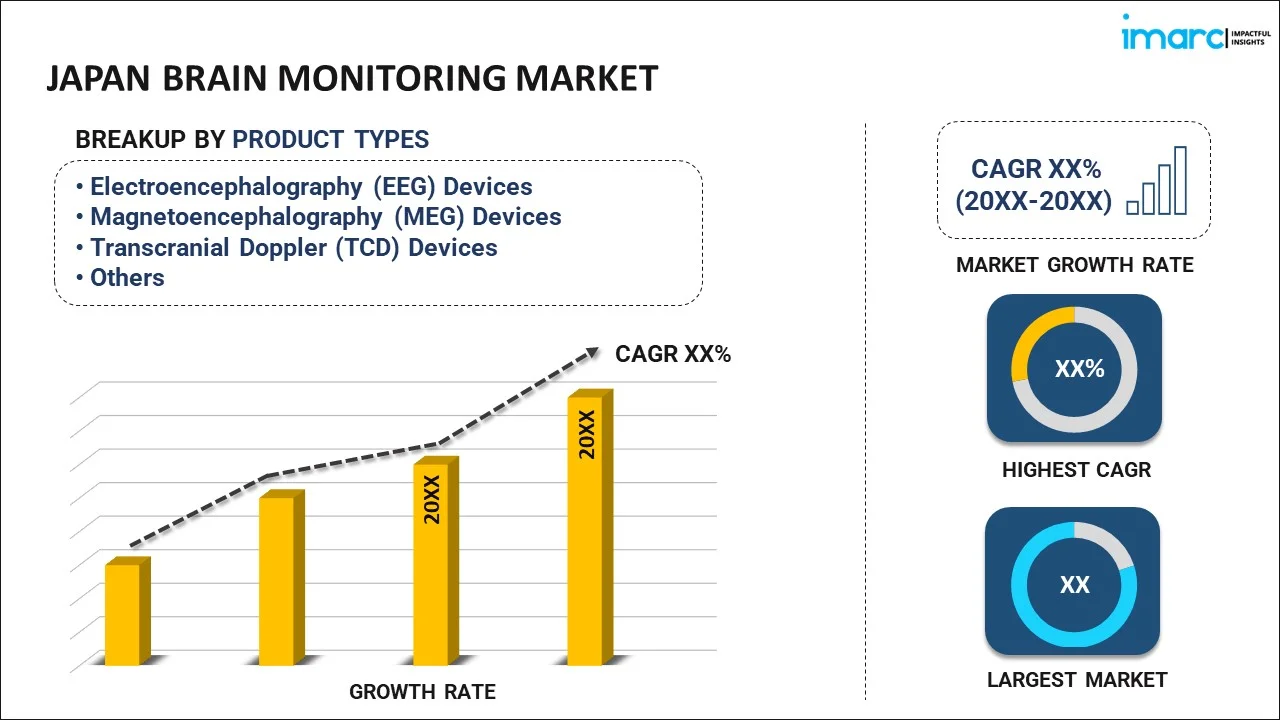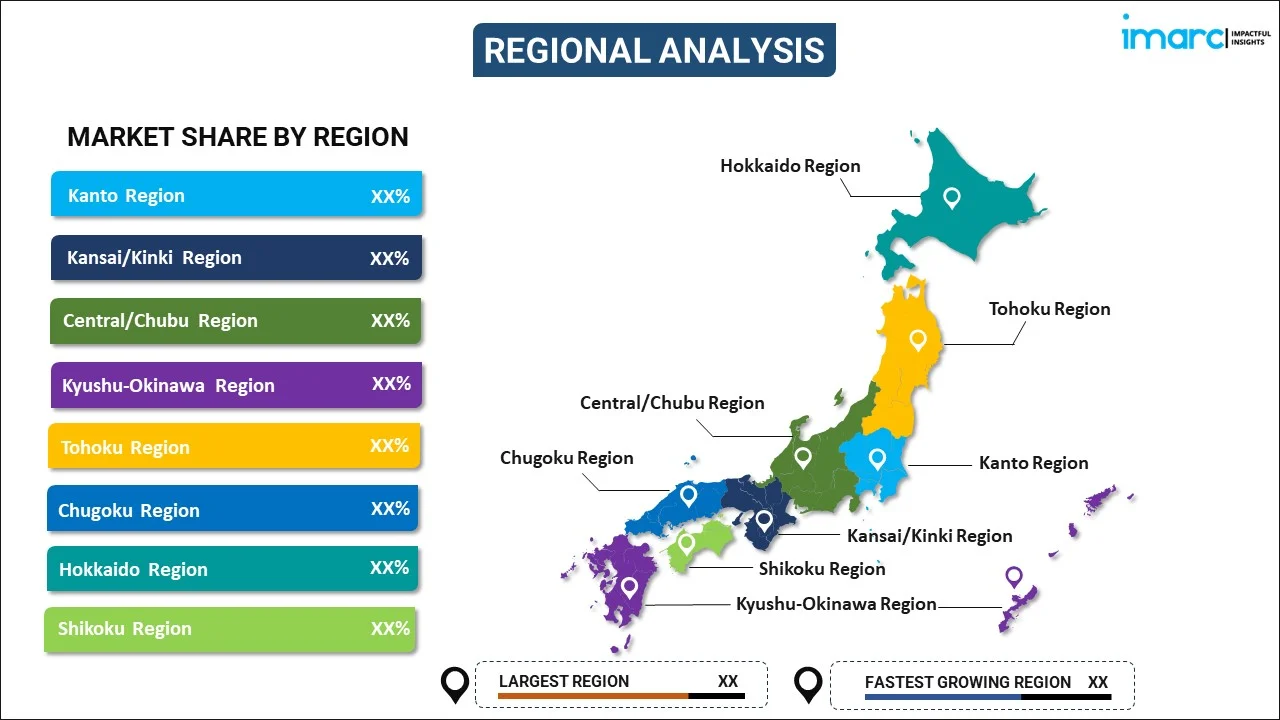
Japan Brain Monitoring Market Report by Product Type (Electroencephalography (EEG) Devices, Magnetoencephalography (MEG) Devices, Transcranial Doppler (TCD) Devices, Intracranial Pressure (ICP) Monitors, Cerebral Oximeters, Magnetic Resonance Imaging (MRI) Devices, Computerized Tomography (CT) Devices, Positron Emission Tomography (PET) Devices, Sleep Monitoring Devices, Electromyography (EMG) Devices, Accessories), Procedure (Invasive, Non-invasive), Application (Parkinson’s Disease, Traumatic Brain Injury (TBI), Epilepsy, Dementia, Sleep Disorders, and Others), End User (Hospitals, Diagnostic Centers), and Region 2025-2033
Market Overview:
Japan brain monitoring market size reached USD 402.2 Million in 2024. Looking forward, IMARC Group expects the market to reach USD 665.7 Million by 2033, exhibiting a growth rate (CAGR) of 5.8% during 2025-2033. The increasing incidence of neurological disorders, such as epilepsy, Alzheimer's disease, Parkinson's disease, and traumatic brain injuries, coupled with the rising demand for monitoring technologies to diagnose, manage, and treat these conditions, is driving the market.
|
Report Attribute
|
Key Statistics
|
|---|---|
|
Base Year
|
2024 |
|
Forecast Years
|
2025-2033
|
|
Historical Years
|
2019-2024
|
| Market Size in 2024 | USD 402.2 Million |
| Market Forecast in 2033 | USD 665.7 Million |
| Market Growth Rate (2025-2033) | 5.8% |
Brain monitoring refers to the continuous and non-invasive process of observing and assessing the activity and functions of the brain. It involves the use of various techniques and technologies to collect data about brain function, structure, and activity. These methods may include electroencephalography (EEG), functional magnetic resonance imaging (fMRI), positron emission tomography (PET), and more. Brain monitoring plays a crucial role in clinical medicine, neuroscience research, and the treatment of neurological disorders. In clinical settings, it helps diagnose conditions such as epilepsy, stroke, and traumatic brain injuries, enabling timely interventions. In research, it provides insights into brain functioning, helping scientists better understand cognition, emotions, and behavior. Additionally, brain monitoring is increasingly used in non-medical contexts like brain-computer interfaces, allowing individuals to control external devices using their thoughts. Advancements in brain monitoring technology continue to enhance understanding of the brain's intricacies and hold promise for improving healthcare, neuroscience, and human-machine interactions.
Japan Brain Monitoring Market Trends:
The brain monitoring market in Japan is experiencing robust growth, driven by several key factors. Firstly, the rising prevalence of neurological disorders, such as epilepsy, Alzheimer's disease, and Parkinson's disease, has created a substantial demand for advanced brain monitoring devices. Moreover, the aging regional population is contributing to the market's expansion, as age is a significant risk factor for many neurological conditions. In addition to demographic trends, technological advancements have played a pivotal role in propelling the brain monitoring market forward. The development of innovative brain monitoring technologies, such as EEG devices with enhanced precision and non-invasive methods, has attracted both healthcare professionals and patients seeking more accurate diagnostic tools and treatment options. Furthermore, the increasing awareness of the importance of early detection and monitoring of brain-related disorders, which has led to a greater acceptance of brain monitoring devices among healthcare providers and patients, is expected to drive the brain monitoring market in Japan during the forecast period.
Japan Brain Monitoring Market Segmentation:
IMARC Group provides an analysis of the key trends in each segment of the market, along with forecasts at the country level for 2025-2033. Our report has categorized the market based on product type, procedure, application, and end user.
Product Type Insights:

- Electroencephalography (EEG) Devices
- Magnetoencephalography (MEG) Devices
- Transcranial Doppler (TCD) Devices
- Intracranial Pressure (ICP) Monitors
- Cerebral Oximeters
- Magnetic Resonance Imaging (MRI) Devices
- Computerized Tomography (CT) Devices
- Positron Emission Tomography (PET) Devices
- Sleep Monitoring Devices
- Electromyography (EMG) Devices
- Accessories
The report has provided a detailed breakup and analysis of the market based on the product type. This includes electroencephalography (EEG) devices, magnetoencephalography (MEG) devices, transcranial doppler (TCD) devices, intracranial pressure (ICP) monitors, cerebral oximeters, magnetic resonance imaging (MRI) devices, computerized tomography (CT) devices, positron emission tomography (PET) devices, sleep monitoring devices, electromyography (EMG) devices, and accessories.
Procedure Insights:
- Invasive
- Non-invasive
A detailed breakup and analysis of the market based on the procedure have also been provided in the report. This includes invasive and non-invasive
Application Insights:
- Parkinson’s Disease
- Traumatic Brain Injury (TBI)
- Epilepsy
- Dementia
- Sleep Disorders
- Others
The report has provided a detailed breakup and analysis of the market based on the application. This includes parkinson’s disease, traumatic brain injury (TBI), epilepsy, dementia, sleep disorders, and others.
End User Insights:
- Hospitals
- Diagnostic Centers
A detailed breakup and analysis of the market based on the end user have also been provided in the report. This includes hospitals and diagnostic centers.
Regional Insights:

- Kanto Region
- Kansai/Kinki Region
- Central/ Chubu Region
- Kyushu-Okinawa Region
- Tohoku Region
- Chugoku Region
- Hokkaido Region
- Shikoku Region
The report has also provided a comprehensive analysis of all the major regional markets, which include Kanto Region, Kansai/Kinki Region, Central/ Chubu Region, Kyushu-Okinawa Region, Tohoku Region, Chugoku Region, Hokkaido Region, and Shikoku Region.
Competitive Landscape:
The market research report has also provided a comprehensive analysis of the competitive landscape. Competitive analysis such as market structure, key player positioning, top winning strategies, competitive dashboard, and company evaluation quadrant has been covered in the report. Also, detailed profiles of all major companies have been provided.
Japan Brain Monitoring Market Report Coverage:
| Report Features | Details |
|---|---|
| Base Year of the Analysis | 2024 |
| Historical Period | 2019-2024 |
| Forecast Period | 2025-2033 |
| Units | Million USD |
| Scope of the Report | Exploration of Historical and Forecast Trends, Industry Catalysts and Challenges, Segment-Wise Historical and Predictive Market Assessment:
|
| Product Types Covered | Electroencephalography (EEG) Devices, Magnetoencephalography (MEG) Devices, Transcranial Doppler (TCD) Devices, Intracranial Pressure (ICP) Monitors, Cerebral Oximeters, Magnetic Resonance Imaging (MRI) Devices, Computerized Tomography (CT) Devices, Positron Emission Tomography (PET) Devices, Sleep Monitoring Devices, Electromyography (EMG) Devices, Accessories |
| Procedures Covered | Invasive, Non-invasive |
| Applications Covered | Parkinson’s Disease, Traumatic Brain Injury (TBI), Epilepsy, Dementia, Sleep Disorders, Others |
| End Users Covered | Hospitals, Diagnostic Centers |
| Regions Covered | Kanto Region, Kansai/Kinki Region, Central/ Chubu Region, Kyushu-Okinawa Region, Tohoku Region, Chugoku Region, Hokkaido Region, Shikoku Region |
| Customization Scope | 10% Free Customization |
| Post-Sale Analyst Support | 10-12 Weeks |
| Delivery Format | PDF and Excel through Email (We can also provide the editable version of the report in PPT/Word format on special request) |
Key Questions Answered in This Report:
- How has the Japan brain monitoring market performed so far and how will it perform in the coming years?
- What has been the impact of COVID-19 on the Japan brain monitoring market?
- What is the breakup of the Japan brain monitoring market on the basis of product type?
- What is the breakup of the Japan brain monitoring market on the basis of procedure?
- What is the breakup of the Japan brain monitoring market on the basis of application?
- What is the breakup of the Japan brain monitoring market on the basis of end user?
- What are the various stages in the value chain of the Japan brain monitoring market?
- What are the key driving factors and challenges in the Japan brain monitoring?
- What is the structure of the Japan brain monitoring market and who are the key players?
- What is the degree of competition in the Japan brain monitoring market?
Key Benefits for Stakeholders:
- IMARC’s industry report offers a comprehensive quantitative analysis of various market segments, historical and current market trends, market forecasts, and dynamics of the Japan brain monitoring market from 2019-2033.
- The research report provides the latest information on the market drivers, challenges, and opportunities in the Japan brain monitoring market.
- Porter's five forces analysis assist stakeholders in assessing the impact of new entrants, competitive rivalry, supplier power, buyer power, and the threat of substitution. It helps stakeholders to analyze the level of competition within the Japan brain monitoring industry and its attractiveness.
- Competitive landscape allows stakeholders to understand their competitive environment and provides an insight into the current positions of key players in the market.
Need more help?
- Speak to our experienced analysts for insights on the current market scenarios.
- Include additional segments and countries to customize the report as per your requirement.
- Gain an unparalleled competitive advantage in your domain by understanding how to utilize the report and positively impacting your operations and revenue.
- For further assistance, please connect with our analysts.
 Inquire Before Buying
Inquire Before Buying
 Speak to an Analyst
Speak to an Analyst
 Request Brochure
Request Brochure
 Request Customization
Request Customization




.webp)




.webp)












